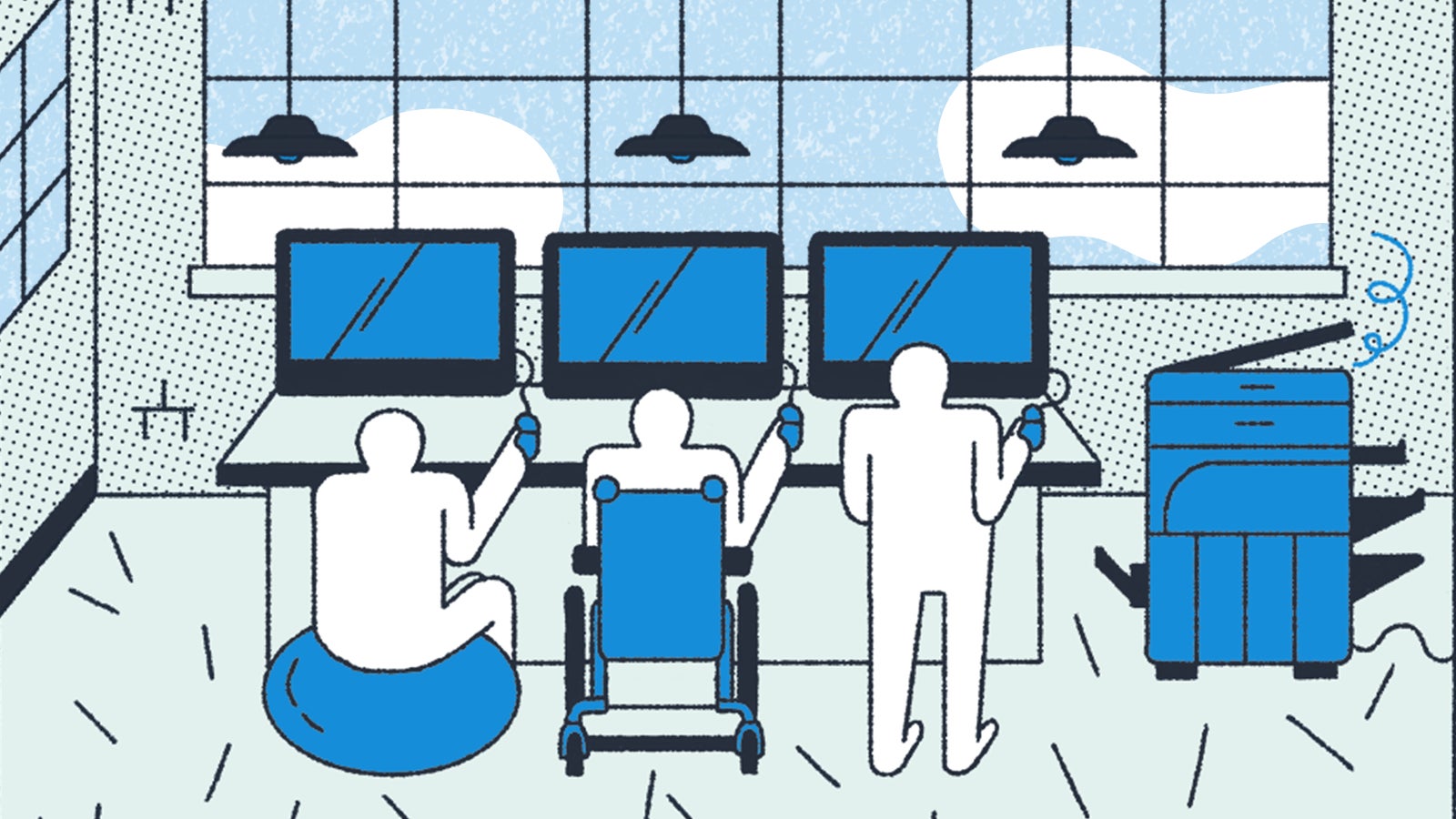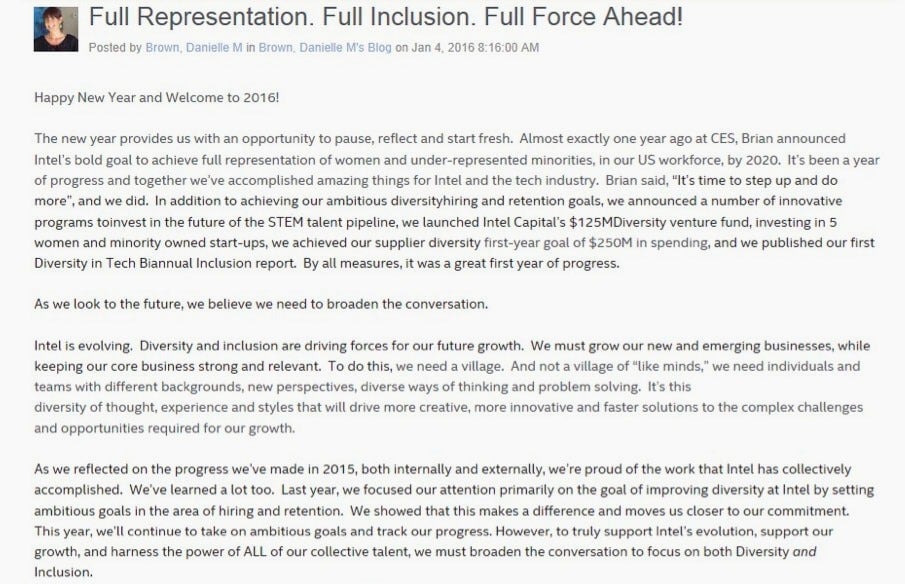Intel’s fixing its diversity problem by doing more than just hiring
In this series, Perfect Company, we are examining pockets of excellence in the corporate world. No single company is perfect, but together they show what the corporate ideal could look like.


In this series, Perfect Company, we are examining pockets of excellence in the corporate world. No single company is perfect, but together they show what the corporate ideal could look like.
The platonic ideal
“We are at our best when we draw on the talents of all parts of our society, and our greatest accomplishments are achieved when diverse perspectives are brought to bear to overcome our greatest challenges.” —Barack Obama in 2011
The practice
Genevieve Bell, who’s been at Intel since 1998, was running late for her call, so she quickly ducked into the gender-neutral bathroom at the company’s Santa Clara, California, headquarters before plopping herself down on the floor to dial in.
“Intel today feels like a profoundly different company than I was at even five years ago,” says Bell, a cultural anthropologist, senior fellow, and vice president at Intel.
These days, it seems almost every major tech company in Silicon Valley has publicly committed to building a more diverse workforce. But it’s a topic Bell, a self-described radical feminist, has been thinking about since she first arrived at the company 18 years ago. “I had at least one boss who told me my career would be much better if I stopped talking about diversity,” says Bell. She was one of the first social scientists hired by Intel to conduct field work to understand what women and people in the “rest of world” (a term she hates) want from technology. “I survived, and he didn’t.”
Like its peers, Intel is overwhelmingly male, white, and Asian, and the diversity problem is a particularly tough one to tackle because 85% of its 100,000 or so employees are in technical roles, which is where the industry’s efforts to improve diversity have largely stalled. “They really have to make a dent on the technical side,” says Elizabeth Ames, a senior vice president at the Anita Borg Institute, which advocates on behalf of women in technology. “I think it’s really impressive that Intel is not only making this dent, but they are continuing to sustain it.”
Since 2000, long before companies like Google and Facebook began releasing their diversity stats, Intel made its EEO-1 reports, which are filed with the US government and break down staff race and gender across all ranks, publicly available.
Transparency was a good first step, and key to holding the company accountable, but it alone wasn’t enough. To show it was really committed to the cause, Intel CEO Brian Krzanich went on stage at the 2015 International Consumer Electronics Show (CES), arguably the biggest tech convention of the year, to proclaim the company would reach full representation—meaning the makeup of its staff would mirror market availability across different types of roles—by 2020.
This aspiration might seem basic, but it’s rare for a tech company to set specific, measurable goals. While full representation is also a realistic goal, it’s proved largely out of reach for the tech industry. According to Intel’s market availability data, women make up 22.7% of available talent for technical roles while Hispanics and African Americans comprise 8.4% and 4.5%, respectively. At Facebook and Alphabet, Google’s parent company, for example, Hispanics and blacks make up 3% and 1%, respectively, of technical roles. Women comprise 17% of tech staff at Facebook and 19% at Alphabet.
“It’s time to step up and do more,” Krzanich declared in his keynote address. “It’s not good enough to say we value diversity.” He said Intel would commit $300 million to invest in startups created by women and underrepresented minorities, help define computer science curriculum at high schools, offer internships to diverse students, and send Intel employees to schools to mentor minority students.
This was in addition to Intel’s other initiatives to recruit, retain, and promote diverse employees. This year the company started requiring managers to interview a diverse slate of candidates for open roles, and for a diverse group of employees to interview job candidates. The company doesn’t mandate specific quotas, but continues to emphasize diversity with hiring managers and will enlist the help of recruiters to fill these slates too.
Intel also runs a “pay it forward” program that identifies and connects promising employees with mentors within the company who help groom them into leaders. “I’m a product of the sponsorship protege program,” says Sandra Lopez, vice president of Intel’s new devices group and member of Intel’s Hispanic Leadership Council. “I had a sponsor, and she helped me understand what I needed to do to be a leader and grow and develop. As a result, I became a VP.”
It’s a common refrain for tech companies to attribute their lack of diversity to the “pipeline problem,” the notion that there aren’t enough qualified women and minorities to recruit from. Intel, however, believes it can approach the diversity problem from a variety of angles, including keeping its existing employees.
“I always say if you just focus on hiring and everyone’s [headed] toward the door, it’s a zero-sum game,” remarks Danielle Brown, Intel’s chief diversity and inclusion officer.
To retain its employees, Intel has worked to build a welcoming work environment, one where employees feel there are opportunities to grow their careers. One attempt to do so is a program called Rapid Orientation for Accelerated Results (ROAR), which brings new hires to headquarters for a week to meet with company leaders and attend workshops on career development. Intel believes there’s a ripple effect in promoting diverse employees to managerial roles, who are likely to attract, hire, and mentor other women and underrepresented minorities.

When the company first started the program in 2015, it was available only to women. But this year, Intel opened ROAR to diverse hires, which Brown says is key to achieving Intel’s diversity goals. “If we made the choice to be exclusive instead of inclusive, it wouldn’t be received very well,” she adds. “We truly believe for this to work you have to take the inclusive approach.” This same approach has been taken with other initiatives as well, tested first with a smaller group, such as new hires within the last year, before opening it up to more employees.
The takeaways
While progress is slow, according to Intel’s most recent diversity report released Aug. 10, women now make up 25% of the company’s US employees and 21% of technical staff in the US. In addition, underrepresented minorities comprise 12% of its US employees and technical employees.
In the first half of 2016, however, Intel saw a slight decline in the percentage of women and underrepresented minorities in their early careers. The company explains this is a result of a shift in focus from PCs to the cloud and connected devices, which led to fluctuations in its hiring numbers and increases in people leaving the company. But the company insists it’s still committed to its goal of full representation by 2020.
In Silicon Valley, where cars drive themselves and marijuana shows up an hour after it’s ordered, diversity has proven to be a problem with no easy solution. Intel knows there’s more than just the pipeline problem, which it’s committed to fixing. To grow and maintain diversity, it’s also working to keep existing staff happy and getting all employees—not just the underrepresented—on board with the company’s goals.
“This is big, big culture change,” says Brown. “It’s really changing the way a company practices hiring, how they think about internal movement and development, how they think about retention. Those changes take time, and I think we’re all impatient for change to happen quickly.”